
iBet uBet web content aggregator. Adding the entire web to your favor.
Link to original content: https://www.internationalrivers.org/feed/

The post Voices from the Tapajos: Advancing Legal Protections for the River’s Future appeared first on International Rivers.
]]>Text in Portuguese follows below
Every visit to Santarém, along the banks of the Tapajós River, stirs deep memories. For over 14 years, International Rivers has worked with local organizations to defend rivers and community rights in the Tapajós Basin, one of the Amazon’s most biodiverse regions. This commitment was captured in our 2022 publication, Tapajós Sob o Sol, which documents the profound environmental and cultural importance of the river and highlights the ongoing threats it faces.
Last month, we returned to the region to co-host with the Tapajós Vivo Movement a meeting with key allies focused on the legal protection of the Tapajós River. This gathering brought together 56 representatives from socio-environmental organizations and Indigenous and local leaders to inform an ongoing legal analysis of the prospects for permanent protections, including pursuing a rights of nature approach. The event also explored collective strategies for strengthening legal protections for the Tapajós and the communities and biodiversity it sustains.

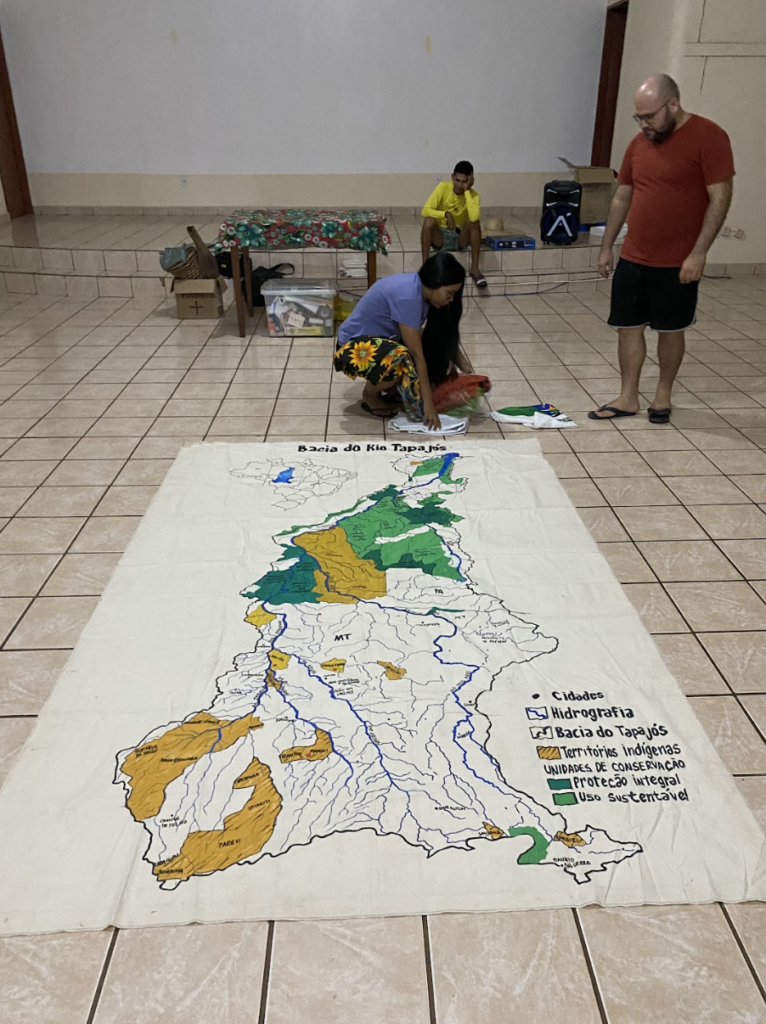

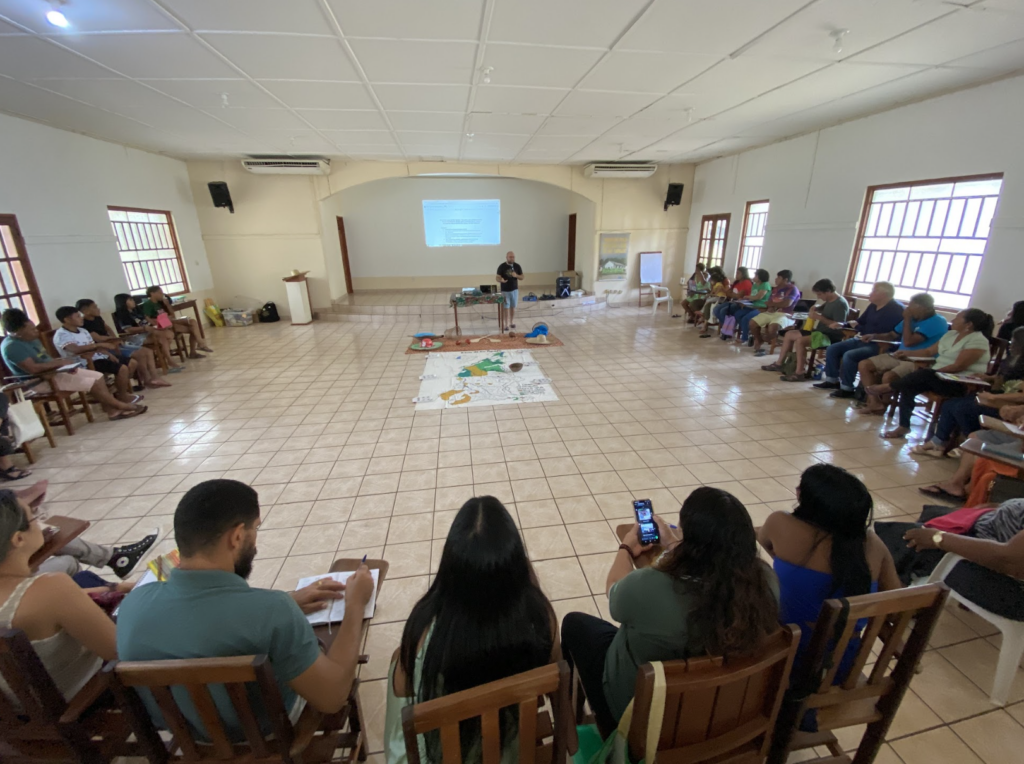

Upon arriving in Santarém, we saw the devastating impact of climate change firsthand: the Tapajós River is experiencing its worst drought on record, with temperatures 2.7ºC above the historical average.
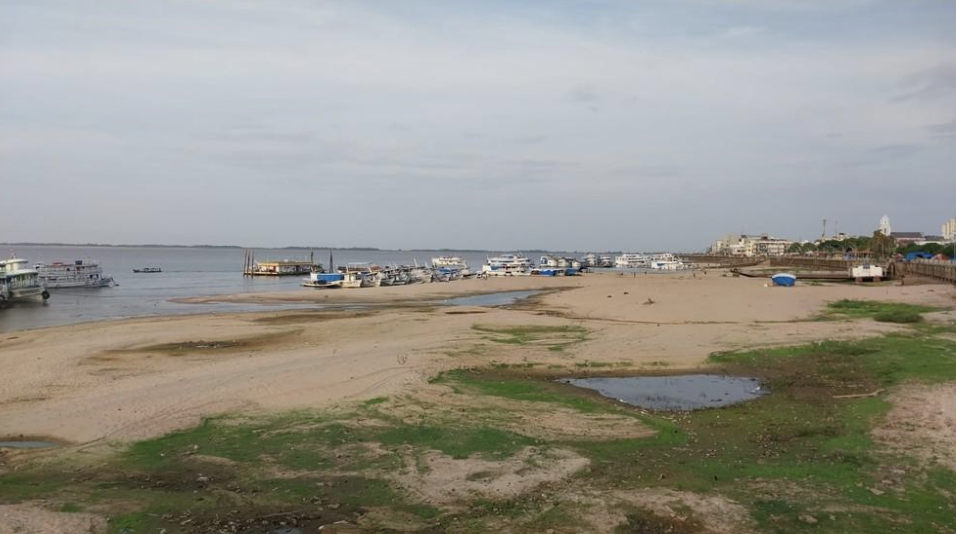
During the meeting, participants discussed the main barriers to legally protecting the river, the types of destructive projects threatening its health, and the role of each organization in safeguarding it. There was unanimous agreement that any legal framework for the Tapajós must be community-led to ensure its strength and legitimacy at all levels of government.
“Legal protection [of the river] ]is important, but without community input, it can’t succeed. ”
Alessandra Korap, Indigenous leader and Munduruku activist


The event highlighted ongoing initiatives such as the Guardians of Good Living, who are advocating for municipal recognition of the Arapiuns River as a rights-bearing entity. Additionally, participants discussed integrating Indigenous and Quilombola land protections with river protections, as these areas are closely tied to the river’s health.
There were also testimonies on the hardships facing communities due to the drought and infrastructure threats like the Ferrogrão Railway, which would disrupt the river basin. As Fred Vieira from the Movement of People Affected by Dams (MAB) explained:
“The Ferrogrão Railway threatens our communities, turning the Tapajós Basin into an export corridor while leaving locals in poverty.”
The meeting concluded with the formation of working groups to establish a Popular Committee for the Tapajós Basin and address urgent water and food security needs. A report will be sent to the Ministry of Integration and Regional Development on the drought’s impact, and a letter to the National Water Agency will request projections on future water availability.
Participants reaffirmed their support for International Rivers’ study and committed to advancing these initiatives. The gathering closed with a symbolic ritual marking a collective commitment to protect the Tapajós.
Long live the Tapajós River! A River for Life, not for Death!
Vozes do Tapajós: Avançando com Proteções Legais para o Futuro do Rio
Por Flávio Montiel
Cada visita a Santarém, às margens do Rio Tapajós, traz muitas recordações. Há mais de 14 anos, a International Rivers tem trabalhado com organizações locais para defender os rios e os direitos das comunidades na Bacia do Tapajós, uma das regiões mais biodiversas da Amazônia. Esse compromisso foi registrado em nossa publicação de 2022, Tapajós Sob o Sol, que documenta a importância ambiental e cultural do rio e destaca as contínuas ameaças que o Tapajós enfrenta.
No mês passado, retornamos à região para organizar, junto com o Movimento Tapajós Vivo, um encontro com líderes locais focado na proteção legal do Rio Tapajós. O evento reuniu 56 representantes de organizações socioambientais e líderes indígenas e locais para contribuir com uma análise jurídica que está em andamento sobre as perspectivas de proteções permanentes, incluindo a abordagem de direitos da natureza. A ação também explorou estratégias coletivas para fortalecer as proteções legais para o Tapajós e para as comunidades e biodiversidade que dele dependem.
Ao chegarmos em Santarém, vimos de perto o impacto devastador das mudanças climáticas: o Rio Tapajós está passando por sua pior seca já registrada, com temperaturas 2,7°C acima da média histórica.
Durante o encontro, os participantes discutiram os principais desafios para proteger legalmente o rio, os tipos de projetos destrutivos que ameaçam sua saúde e o papel de cada organização na sua defesa. Houve um consenso de que qualquer estrutura legal para o Tapajós deve ser liderada pela comunidade para garantir sua força e legitimidade em todos os níveis de governo.
Alessandra Korap, uma líder indígena e ativista Munduruku, afirmou: “A proteção legal [do rio] é importante, mas sem a participação da comunidade, não pode ter sucesso.”
O evento também destacou iniciativas em andamento, como os Guardiões do Bem Viver, que estão defendendo o reconhecimento municipal do Rio Arapiuns como uma entidade portadora de direitos. Além disso, os participantes discutiram a integração das proteções de terras indígenas e quilombolas com as proteções do rio, pois essas áreas estão intimamente ligadas à saúde do rio.
Houve também depoimentos sobre as dificuldades enfrentadas pelas comunidades devido à seca e às ameaças de infraestrutura, como a Ferrogrão, que impactaria a bacia do rio. Como explicou Fred Vieira, do Movimento dos Atingidos por Barragens (MAB): “A Ferrogrão ameaça nossas comunidades, transformando a Bacia do Tapajós em um corredor de exportação e deixando os locais na pobreza.”
O encontro terminou sendo responsável pela formação de grupos de trabalho para estabelecer um Comitê Popular para a Bacia do Tapajós e abordar necessidades urgentes de segurança hídrica e alimentar. Um relatório será enviado ao Ministério da Integração e do Desenvolvimento Regional sobre o impacto da seca, e uma carta para a Agência Nacional de Águas solicitará projeções sobre a disponibilidade futura de água.
Os participantes reafirmaram seu apoio ao estudo da International Rivers e se comprometeram a avançar com essas iniciativas. O evento terminou com um ritual simbólico marcando um compromisso coletivo de proteger o Tapajós.
Vivia o Rio Tapajós! Rio é Vida e não Morte!!
The post Voices from the Tapajos: Advancing Legal Protections for the River’s Future appeared first on International Rivers.
]]>The post Historic Drought on the Tapajós River Devastates Riverine Communities in the Amazon appeared first on International Rivers.
]]>A series of photographs taken by Araquem Alcântara reveals just how stark the situation is.
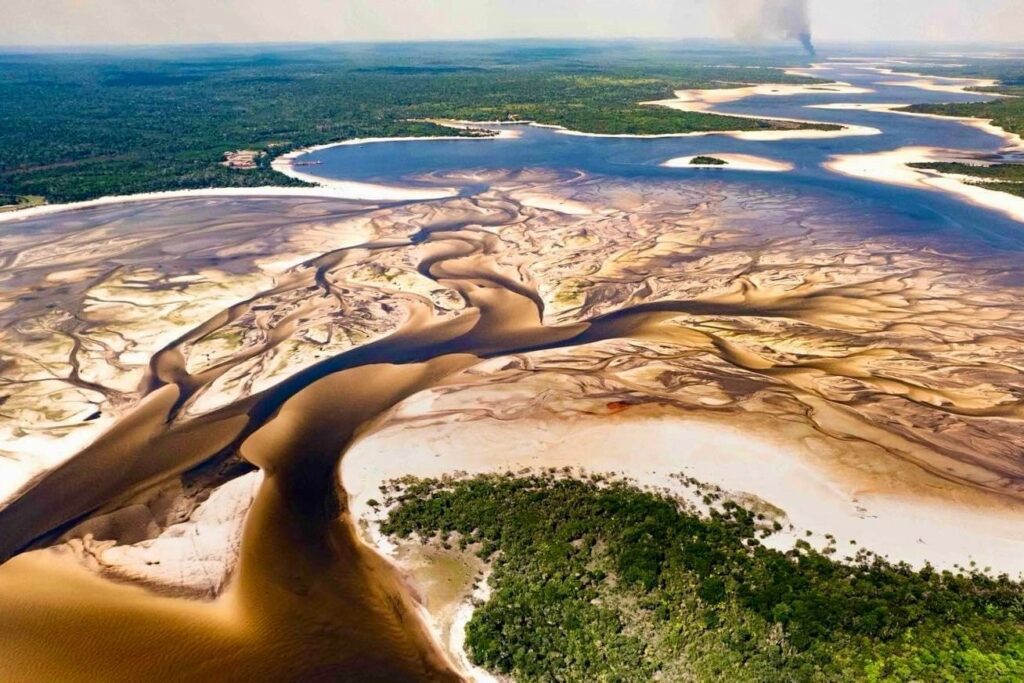
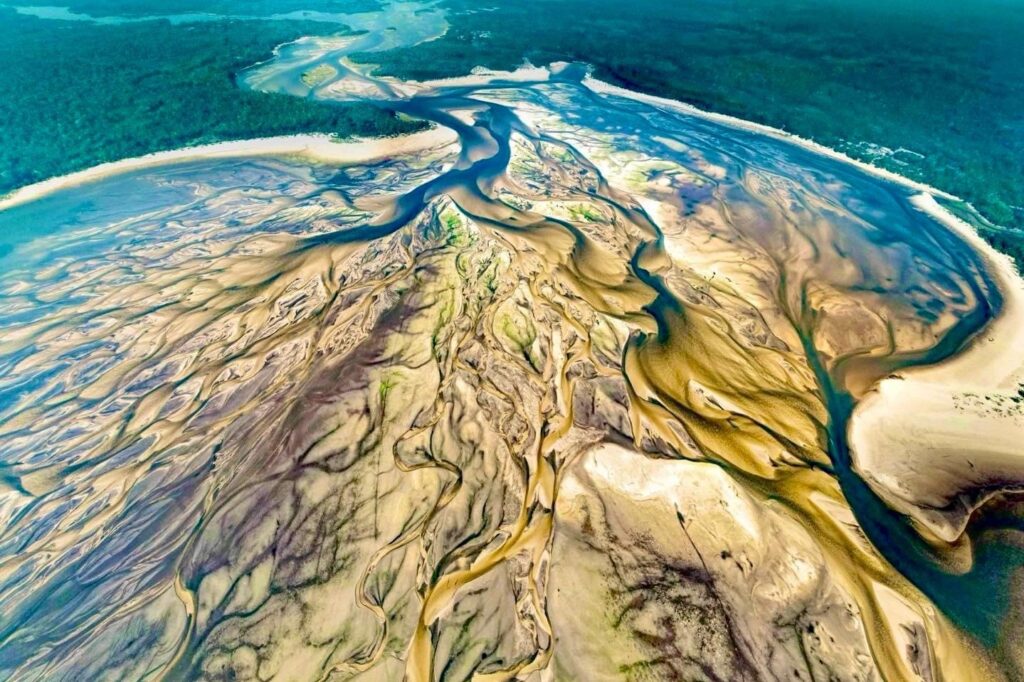

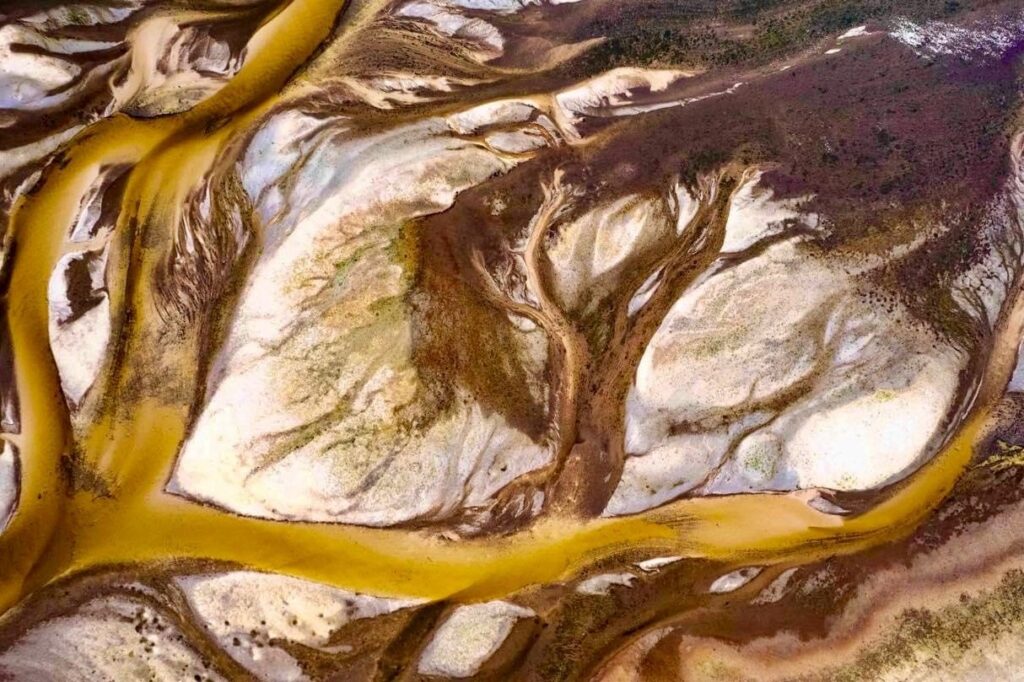
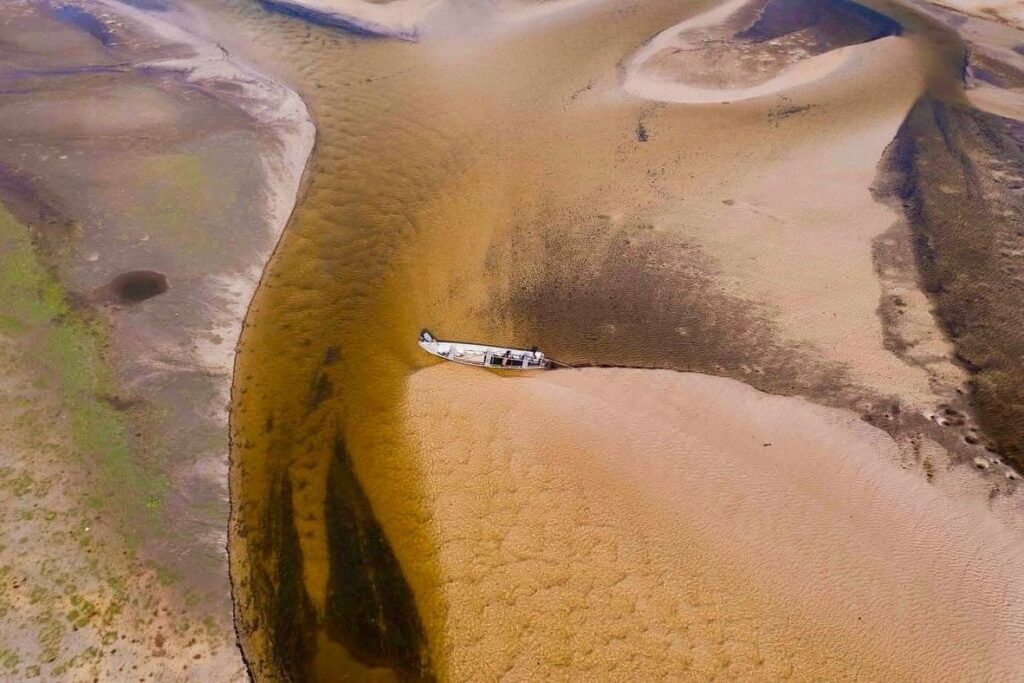
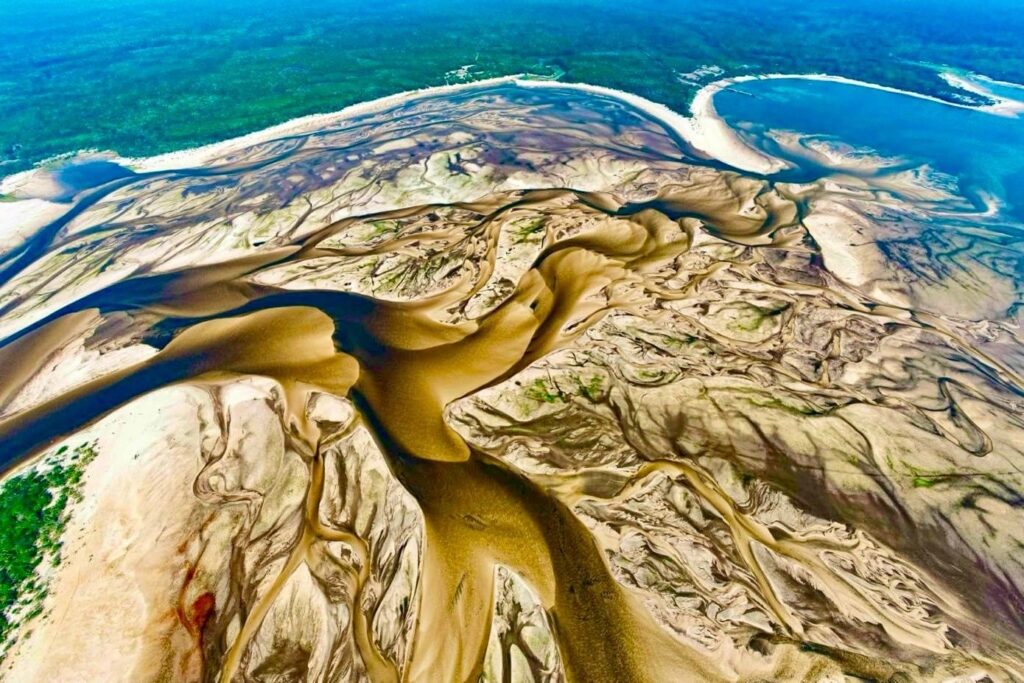
Photo credit: Araquem Alcântara
The situation has severely impacted riverine communities that rely on the Tapajós for transport, commerce, and daily sustenance. River transport, crucial for accessing remote areas and transporting goods, has become increasingly challenging. In communities like Boim, school transport services are struggling to reach schools, with some children being carried to avoid missing classes. While droughts are part of the Amazon’s natural cycle, the frequency and severity of such events have escalated as a result of the climate crisis, turning what used to be rare occurrences into a troubling new norm for the region.
The situation is not limited to the Tapajos River, as SUMAUMA reported in this interactive map of major rivers in the Amazon. According to Brazil’s Minister of Environment and Climate Change, 58% of the country is currently affected by drought, the worst seen in 75 years.
Because of the alarming situation, International Rivers has joined other social movements and organizations calling on governments to take emergency and structural action on the climate crisis. Read the full letter here (Portuguese).
Feature photo: Araquem Alcântara
The post Historic Drought on the Tapajós River Devastates Riverine Communities in the Amazon appeared first on International Rivers.
]]>The post Thailand’s National Human Rights Commission Raises Serious Concerns about Impacts of Mekong River Dams appeared first on International Rivers.
]]>In early October, the National Human Rights Commission of Thailand (NHRC) sent a letter to Thailand’s Prime Minister expressing serious concerns about the plans for four more hydropower projects to be built on the mainstream of the Mekong River near the Thai-Lao territorial border— namely, the Sanakham, Pak Chom, Ban Kum and Phu Ngoy dams, all of which will be constructed in Laos but are expected to export electricity to Thailand.
The NHRC letter to the Prime Minister comes in the midst of several high profile incidents of flooding of communities residing along the Mekong riverbanks and its tributaries. It is particularly timely, as the Thai government has been updating the country’s Power Development Plan (PDP) using assumptions based on outdated data and a process which has bypassed meaningful public participation. Meanwhile, government authorities have also failed to provide any assurance that adequate assessment of transboundary impacts have been done prior to moving forward with plans for this massive build-out of hydropower dams. On these matters, crucially, the NHRC findings and recommendations provided to the government echo critical concerns raised persistently by civil society and community based groups in Thailand as well as across the Mekong region.

Site of the proposed Sanakham Dam (October 2023). Credit: International Rivers
Findings Informed by Comprehensive Investigation Process
The NHRC letter to the Prime Minister is the result of an investigation by the NHRC undertaken in response to a joint complaint filed in June 2023 by ETOs Watch Coalition — a network of civil society groups, including International Rivers, which together monitors the human rights and environmental impacts of Thailand’s outbound investments — and the Thai Mekong People’s Network. Commissioners and their staff took the time to not only review documents at hand, but also heard testimonies directly from members of the communities along the Mekong who will be affected by the development of these dams, engaged with civil society groups and academics, held dialogues with local and national government bodies, and undertook site visits to areas within Thailand that stand to be affected by the Sanakham and Phu Ngoy Dam sites.
NHRC’s key findings, which focused on how Thailand and Thai communities will be affected by the development of these dams, highlighted the critical need to consider the following:
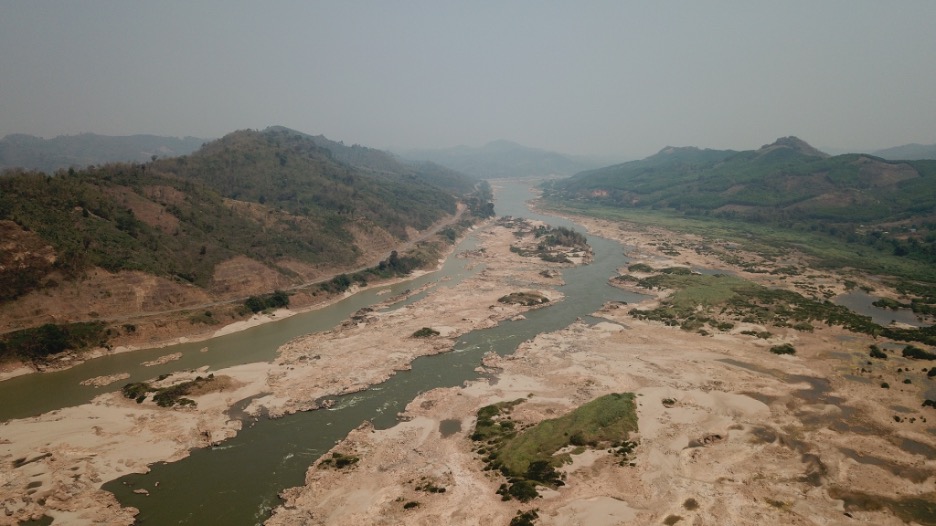
Site of the proposed Pak Chom Dam, downstream from the Xayaburi Dam along the Mekong River. View from Pak Chom District, Loei Province, Thailand at the Thai-Lao Border (March 2024). Credit: Chairat Jirojmontree,Transborder News
Human Rights Commission Recommendations Highlight the Need to Act Now
Given the reality that Thai actors are implicated in the plans for these four dams — as developers, potential financiers, buyers of electricity and consumers — as well as the fact that it will be communities in Thailand and national territorial areas that stand to be impacted, the NHRC applied relevant provisions of the Thai constitution and recent Thai government plans and commitments – such as the updated 2nd National Action Plan on Business and Human Rights (2023) – to inform their recommendations to the Thai Prime Minister and relevant agencies.
The Commissioners concluded that:
Now after having received unequivocal recommendations from the NHRC, the Thai Government has an opportunity to act before it is too late. Crucially, all four dams to which the NHRC is bringing attention are still in the planning stages. Any initial negotiations for purchasing of power, as well as business deals getting underway for construction need not move forward. The evidence speaks for itself — the first hydropower project on the mainstream Mekong, the Xayaburi Dam, is already taking a severe toll on the livelihoods of riparian communities and riverine ecology with no realistic mitigation, redress or reparative measures in sight. Meanwhile, Thailand already has a margin of approximately 40% excess in electricity reserves.
In the face of the climate crisis, we have also witnessed how unpredictable extreme weather incidents such as extended droughts and flash floods are becoming more frequent, impacting reliability of hydropower generation and increasing risks on riparian communities. Meanwhile, comprehensive studies of the carbon emissions from dams provide clear indications that potent greenhouse gasses are produced during the construction of concrete dam walls, during the filling of reservoirs as debris of inundated lands rots, as well as from eutrophication of the water and degassing at the turbines over the years of operation, while destroying the natural carbon sequestration processes of flowing river ecosystems. Damming the Mekong River is not a low-carbon energy solution but rather a highly resource intensive venture which has no place in a just energy transition.
Coming to the conclusion that these dams are not needed and that plans need to be permanently withdrawn should not be in question. What remains to be seen is whether the staff of relevant state agencies and ultimately, those in the Prime Minister’s office, will take the NHRC recommendations to heart — upholding their stated commitment to the UNGPs, moving forward with courage to abrogate any further discussions over these projects and taking a clear position in favor of the intergenerational rights of Mekong communities in Thailand and beyond.
The post Thailand’s National Human Rights Commission Raises Serious Concerns about Impacts of Mekong River Dams appeared first on International Rivers.
]]>The post Rising Tides of Hope: Advancing River Protection at COP16 CBD appeared first on International Rivers.
]]>Returning to Colombia, my birthplace, for the UN Biodiversity Conference (COP16) in Cali was both deeply nostalgic and profoundly meaningful. The city’s warm weather and intermittent showers over the past few weeks mirrored the vibrant yet urgent tone of the conference. With its unparalleled biodiversity and mounting pressures on nature, Colombia provided a fitting backdrop—especially as the return of peace has opened new areas to development, presenting both opportunities and significant risks.
Representing International Rivers, my focus was on freshwater ecosystems, which took center stage in our agenda at COP15 in Montreal two years ago. Working alongside partners, we secured a significant milestone: the recognition of “inland waters” as a distinct category, separate from marine and terrestrial biodiversity. Yet the challenges remain stark.
And yet, freshwater did not feature prominently on COP16’s official agenda, and indeed this COP revealed a concerning truth: not enough attention was given to the protection of continental and freshwater ecosystems, despite their crucial role in the global biodiversity agenda. Still, I was encouraged by the passionate advocacy from civil society organizations across the globe. Their voices championed meaningful targets, robust monitoring, and increased resources to protect some of the planet’s most biodiverse habitats. This focus was particularly relevant given that Colombia hosts the headwaters of several of the region’s most ecologically rich rivers, including major tributaries of the Amazon.
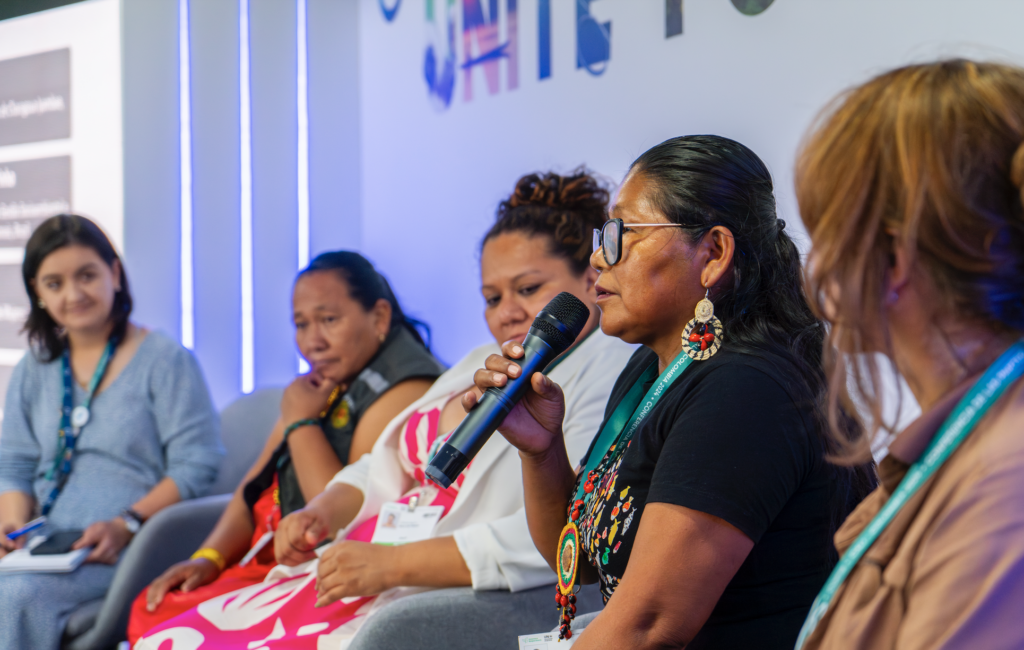
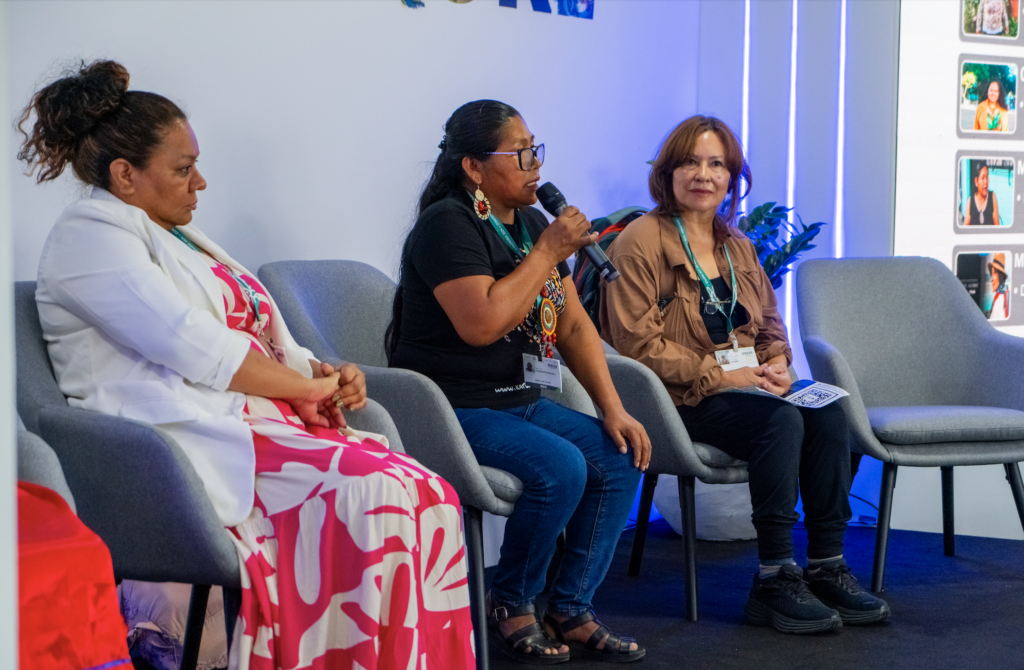
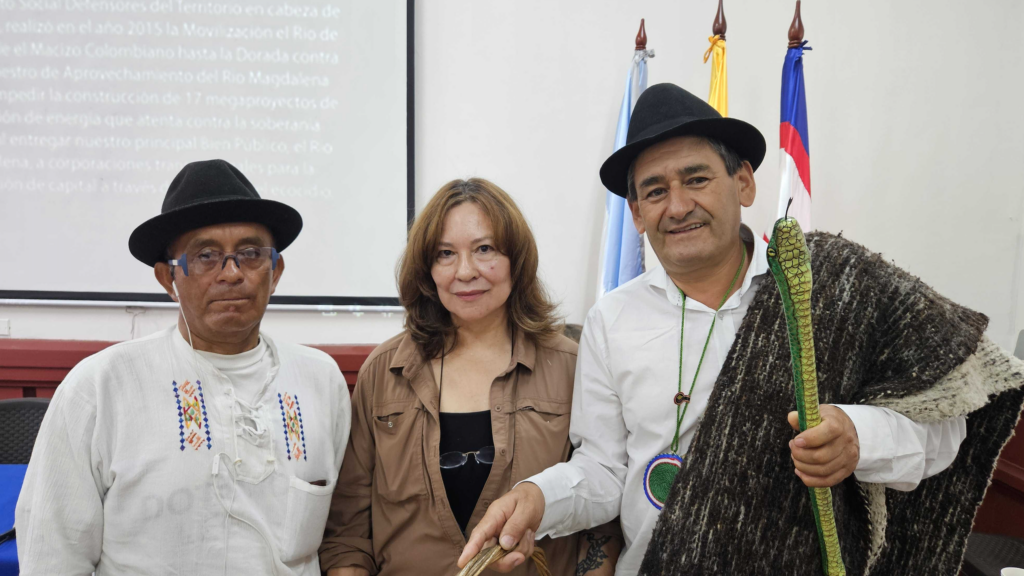
From global conservation groups to grassroots river defenders, there was a palpable sense of collective power, even in the face of resistance from skeptical governments and corporate sponsors. The conference also marked a historic moment for Indigenous Peoples, who, for the first time, had a formal seat at the negotiating table. Their leadership was pivotal, pushing for the protection of their traditional knowledge and the ecosystems they’ve stewarded for generations.
Progress on critical issues—setting measurable targets, establishing mechanisms to monitor and report progress, and securing the necessary funding to protect 30% of the world’s biodiversity by 2030—was predictably slow. Yet, there were moments of true celebration.
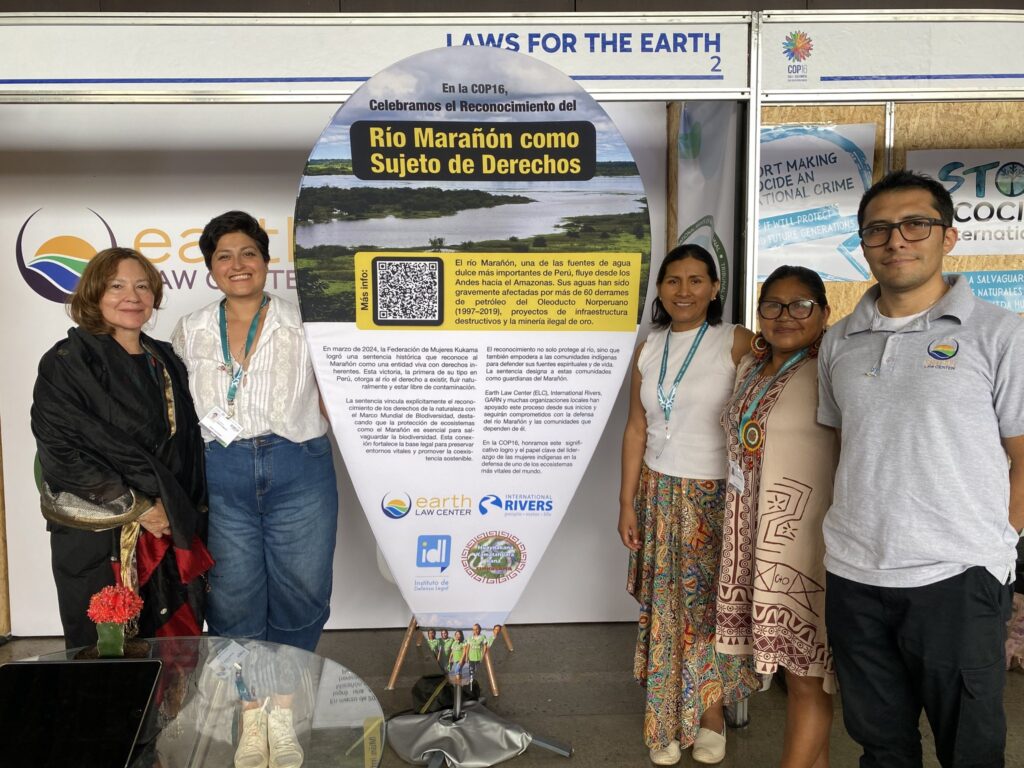
One of the most powerful was the unexpected announcement of a legal victory for the Marañón River in Peru. Together with Mariluz Canaquiri, a Kukama leader and long-time advocate for the Marañón, we celebrated this historic decision. Now recognized as a legal entity, the Marañón River has the right to flow, remain free from pollution, and be restored. Importantly, the ruling formalized Indigenous communities as its guardians, setting a global precedent for river protection. This victory was a tangible example of what many at COP16 are fighting for—the recognition of rivers as living entities with rights.
We also had the opportunity to visit the Pance River near Cali, a rights-bearing river safeguarded by local communities and supported by Earth Law Center. It served as an inspiring example of how legal recognition and community stewardship can restore and sustain freshwater ecosystems.
Other promising river protection initiatives were on display as well. Delegates from Ríos Protegidos Chile shared progress on their Law for the Protection of Rivers, advancing innovative mechanisms for conservation. Similarly, Brazil’s River Protection Coalition brought their advocacy to the global stage, emphasizing the urgent need to protect the Amazon’s tributaries and the Pantanal’s rivers.
As I left Cali, I carried a renewed sense of both urgency and hope. From the thriving Pance River to the groundbreaking legal victory for the Marañón, the global movement for freshwater protection is gaining critical momentum. But the time to act is now. As climate change accelerates and development pressures intensify, safeguarding freshwater systems is not just a conservation priority—it is essential to securing the future of life on Earth.
Let’s rise to the challenge. Long live the rivers!
Featured Photo: Monti Aguirre, Latin America Director of International Rivers (Rios Protegidos)
The post Rising Tides of Hope: Advancing River Protection at COP16 CBD appeared first on International Rivers.
]]>The post Why Saving Rivers Means Saving Democracy appeared first on International Rivers.
]]>The state of democracy affects everything downstream – including, quite literally, our rivers. At International Rivers, where we work with communities living alongside rivers in the Global South, we see this connection every day.
Democracy isn’t just about casting votes. It’s about whose voices matter in the decisions that shape our world. When we work with communities along the banks of the Salween, the Tapajos, the Teesta, the Kunene, we see how the most effective river protection comes when previously marginalized voices – especially those of Indigenous communities, women, youth – are brought to the forefront.
This is democracy in its most essential form: the deep practice of listening to those who have been historically sidelined. It’s about recognizing that the best decisions come from diverse perspectives, especially from those who bear the brunt of environmental degradation.
The challenges to democracy that we’re witnessing globally are more than abstract political issues – they have real consequences for environmental and social justice. When democratic institutions weaken, environmental protections and human rights often follow suit. We’ve seen how autocratic tendencies frequently align with the dismantling of environmental safeguards, the silencing of Indigenous voices, and the prioritization of short-term gain over long-term sustainability.
The path forward requires us to recognize that environmental protection and democratic principles are inseparable. When we talk about saving rivers, we’re also talking about saving the democratic principles that enable communities to stand up for their environmental rights. Every time we help amplify the voice of a riverside community member, every time we ensure women’s participation in water management decisions, we’re not just protecting rivers – we’re strengthening the very fabric of democratic decision-making.
As we navigate these challenging times, our work reminds us that democracy, like a river, requires constant attention and care. It must flow freely, nourished by diverse tributaries of thought and experience. And like the communities we serve, we must remain resolute in our commitment to both environmental and democratic principles, understanding that they flow together toward a more sustainable and just future.
The answers to the problems before us are not easy, but the work is essential. True democracy and environmental protection share the same fundamental principle: the voices of those most affected must be at the center of the decisions that impact their lives.
Featured Photo: Canva
The post Why Saving Rivers Means Saving Democracy appeared first on International Rivers.
]]>The post Peruvian Court Upholds Ruling Recognizing Rights of the Marañón River appeared first on International Rivers.
]]>This landmark decision is a testament to the advocacy of the Huaynakana Kamatahuara Kana Federation, a Kukama women’s organization that has tirelessly fought to safeguard the Marañón from repeated oil spills and environmental degradation. The ruling also sets critical legal precedents by mandating that Petroperú take immediate, comprehensive measures to protect the river from further contamination, and by establishing watershed councils to oversee sustainable river management.
As a supporter of this collective effort, International Rivers celebrates this step forward for Indigenous-led environmental protection and for the growing recognition of rivers as legal entities essential to community resilience and ecosystem preservation.
“The fight for the rights of the Marañón River is not just a battle for water; it is a testament to the resilience of the Kukama people, who stand as guardians of their ancestral lands, protecting their culture, identity, and the lifeblood of the river. In unity, we honor our rights and the sanctity of nature, ensuring that the voices of those who truly belong to this land are heard,” added Monti Aguirre, Latin America Manager of International Rivers.
Read the full press release regarding the ruling below (Spanish version here)
Featured Photo: Members of Huaynakana Kamatahuara Kana Federation at Marañón River (Miguel Araoz/Quisca)
The post Peruvian Court Upholds Ruling Recognizing Rights of the Marañón River appeared first on International Rivers.
]]>The post The World Bank is poised to repeat the mistakes of the past in its embrace of megadams appeared first on International Rivers.
]]>As world leaders gather this week in Washington, DC for the World Bank’s Annual Meetings, over 100 civil society organizations are raising the alarm over the World Bank’s plans to lend billions of dollars for ill-conceived and destructive megadams around the world. A letter sent to the World Bank today notes these plans “will not bring reliable, environmentally sustainable, affordable, accessible electricity” and fail to consider lessons from the Bank’s past failures and ongoing challenges for dam-affected communities seeking redress.
The Bank’s imminent approval of the Rogun dam in Tajikistan would be among the more egregious projects in recent memory. The dam – slated to be the world’s tallest – would displace 60,000 people, irreparably harm the livelihoods of tens of thousands of more, and destroy vast stretches of riparian ecologies in violation of the Bank’s own environmental and social standards. With a conservative price tag of over $11 billion, Rogun would rank among the costliest dams ever built and by far the largest dam the Bank will have supported in decades. With project completion projected to take at least another 15 years, Rogun’s electricity will be significantly more expensive than readily available alternatives. In the short-term, there remain significant risks, cited by the IMF, that the costs of constructing Rogun could lead to an unsustainable debt burden while preventing needed public investments in other sectors, including health and education.
The proposed Upper Arun dam in Nepal and its associated cascade of dams have engendered serious concern over the expected physical, cultural and economic dislocation of Indigenous Peoples without their consent, as required by World Bank policy. At the same time, Nepal’s hydropower output has been and will continue to be curtailed by climate change, while the growing risk of glacial lake outburst floods in the Himalayas poses existential threats to millions downstream. In September last year, the brand new, $1 billion Chungthang dam on the Teesta River washed away in minutes, impacting tens of thousands.
The World Bank’s apparent interest in re-engaging on the ill-fated Inga project in the Democratic Republic of Congo (DRC) is even more inexplicable. Eight years on since it was forced to cancel its $73 million investment in what has been promoted as the world’s largest hydropower scheme, the Bank is trying once again to revive a project that has for decades seen a revolving cast of actors come and go, leaving a trail of broken promises. Congolese civil society and communities have long criticized the project for its expected impacts that would include the displacement of 30,000 people, many of whom were displaced and impoverished by dams previously built at the Inga site; the debt burden that generations of Congolese would be saddled with; and the massive opportunity cost of not exploring energy options better suited to addressing persistent energy poverty.
Unfortunately, none of this is new. The World Bank’s voracious appetite for dams and the resulting legacy of environmental and social impacts led to the creation of the World Commission on Dams (WCD) process, whose recommendations still serve as the standard for how to avoid the worst impacts of dams and whose lessons remain highly relevant today. The WCD process also precipitated a relative fallow period for the Bank in funding new dams, though the size and scale of projects currently under consideration suggests the Bank once again plans to take up the mantle as a prominent financier of megadams.
However, times have changed, and the conditions for developing new dams have worsened considerably in recent years. Large hydropower has rightly fallen out of favor around the world, experiencing several years of decline globally in the face of high costs, dwindling output, the declining costs of renewable alternatives, the steep environmental and social costs, and the climate crisis upending its rationale and purported benefits. The World Bank should learn from the hard-earned lessons of its past and invest in real renewable energy solutions rather than megadams.
Featured Photo: Glen Dam in Page, Arizona (Shutterstock)
The post The World Bank is poised to repeat the mistakes of the past in its embrace of megadams appeared first on International Rivers.
]]>The post International Rivers celebrates the unprecedented victory in removing dams on the Klamath River appeared first on International Rivers.
]]>The decades-long struggle to remove the dams on the Klamath stands as a major success, restoring hundreds of miles of habitat for salmon and other species which have been severely affected by the dams. The dams also devastated the cultures, lives and livelihoods of the Indigenous tribes whose territories and way of life are intimately bound to the Klamath. This Tribal-led victory, supported by a strong coalition of key local, national and international allies and campaign groups, serves as an inspiration to dam-affected communities around the world, who have seen what Indigenous Peoples and their allies can accomplish in the face of daunting odds and powerful vested interests.
This success comes on the heels of the growing trend in Europe and North America to dismantle obsolete dams. However, the Klamath River stands out as the site of the largest dam removal project in history and as a demonstration of how the decommissioning of even major dams can be accomplished.
While there remains much to do to dismantle the thousands of obsolete dams in Europe and North America, the Klamath removals have sparked a conversation in Latin America, Africa, and Asia about what to do with their aging dam fleets. This is particularly true since the Derna dam disaster in Libya last year exposed the risks that aging dams face in an era of extreme weather caused by climate change.
Meanwhile, we have witnessed a major milestone when the International Renewable Energy Agency (IRENA) found that global solar energy capacity eclipsed hydropower as the largest renewable energy source in the world in 2023, as new hydropower continues to shrink year on year. Before long, we will see more dams coming down than going up.
The Klamath dam removal represents hope for rivers and the triumph of Indigenous communities in their efforts to wrest control of their freshwater resources. It also serves as a cautionary tale and reminder of the unintended consequences–for people, fish and the wider environment–of flawed and poorly conceived hydropower projects. Most of the thousands of large dams currently being considered around the world suffer from the same flaws and negative consequences that finally led to the removal of the Klamath dams. These ill-conceived projects should be consigned to the past.
###
Featured images of the Copco No. 2 before after removal, credit Shane Anderson of Swiftwater Films.
The post International Rivers celebrates the unprecedented victory in removing dams on the Klamath River appeared first on International Rivers.
]]>The post A Victory After 15 Years: Land Restitution for Families Displaced by the El Quimbo Dam appeared first on International Rivers.
]]>By Monti Aguirre, Director, Latin America Program
In a long overdue victory, Colombian President Gustavo Petro last week handed over nearly 1000 hectares of land to close to 100 families displaced by the construction of El Quimbo dam. Built on the Magdalena River—Colombia’s most important waterway, vital for the country’s ecosystem, culture, and economy—the dam effectively privatized stretches of the river, resulting in the loss of some of the region’s most productive lands and impoverishing communities whose livelihoods had depended on agriculture and fishing.
The impact of El Quimbo has been devastating, displacing families and severely disrupting artisanal fishers’ livelihoods. Communities reliant on the Magdalena River —some for generations—have faced economic hardship, loss of fishing grounds, and ecosystem destruction. Fishermen and women from Gigante, Hobo, and Campoalegre experienced systematic human rights violations, including harassment, threats, and assassinations. Despite these challenges, they continue to fight for compensation.
This long-delayed step to offer redress to affected communities could signal a broader reckoning with Colombia’s history of dam-induced displacement, which has impacted tens of thousands across the country.
A Long Struggle for Justice
The construction of the 400 MW El Quimbo dam, developed by the multinational company Enel, submerged over 8,500 hectares in the department of Huila, bringing an end to agricultural production that was once worth over $7 million annually.
Communities in Huila had organized as early as 2009 to resist the El Quimbo dam. Under the administration of then-President Uribe, the government evicted nearly 100 families from their lands. After 15 years without a concrete solution for the victims, the National Land Agency (ANT) acquired nearly 5,000 hectares in Huila, with 3,000 of those designated for compensating farmers displaced by the dam. This milestone marked a significant step in addressing the long-standing grievances of those affected.
The land restitution followed the ruling of the Constitutional Court’s T-135/13 decision, which recognized the rights of the displaced families. Many of the beneficiaries of this initial round of reparations were members of Asoquimbo, which has long fought for justice on behalf of those impacted by the dam. However, the government also committed to compensating farmers who were not legally recognized as affected but who still suffered significant losses due to the project.
This initiative by the government could signify the start of a broader effort to address past injustices and ensure that those displaced by development projects are no longer overlooked or forgotten. For the communities of Huila, this represents not just the return of land but the restoration of livelihoods and a new chapter in their fight for justice.
International Rivers, in partnership with Asoquimbo, has been a key ally in supporting affected communities in their fight for justice. International Rivers remains committed to standing with these communities as they seek comprehensive reparations and protection from future threats. While this moment marks a significant milestone, the road ahead remains long, and the fight for their rights, land and river is far from over.
The post A Victory After 15 Years: Land Restitution for Families Displaced by the El Quimbo Dam appeared first on International Rivers.
]]>The post Recognizing the Rights of the Biobío River: A New Era of Environmental Stewardship appeared first on International Rivers.
]]>For the Spanish version, click here.
The Biobío River was Chile’s first major river protection campaign, which later helped shape and inform efforts to protect iconic rivers in Patagonia. The lessons learned from the Biobío campaign laid the groundwork for future advocacy, driving the successful movements to safeguard rivers like the Baker and Pascua from similar threats.
The Biobío is a lifeline, a cultural icon, and a symbol of resilience for its communities. For centuries, it has sustained both the land and its people while supporting rich biodiversity. Yet, relentless human activity has degraded the river, threatening the well-being of the ecosystems and communities that depend on it.
The recent Declaration of Rights of the Biobío River launched this week in Concepción was born from collaboration between Indigenous Peoples, scientists, civil organizations, and local authorities, and marks a historic shift in how we view and protect this vital waterway. The Declaration asserts that the river, along with its tributaries and basin, possesses inherent rights that must be recognized and protected. It is not just a document; it is a moral commitment to restore and safeguard the Biobío River.
My connection with the Biobío River began early on in my tenure at International Rivers. At the time, the late Glenn Switkes was working with Grupo de Acción por el Biobío (GABB), one of Chile’s pioneering environmental organizations led by Juan Pablo Orrego, Cristian Opaso, and others, in a high profile campaign to challenge the World Bank-backed Pangue dam.
This fight took place against the backdrop of the legacy of the Pinochet dictatorship, which had privatized Chile’s economy and sold off the country’s water rights (via the Water Code), mineral resources, forests, and fisheries to private interests, unleashing intense environmental degradation.
Within this context, environmental protections were weak, and those that existed were often undermined by the regime’s focus on resource exploitation. Indigenous peoples’ rights were particularly fragile. The Mapuche communities, whose culture and livelihoods were closely tied to the Biobío, faced significant threats. Mapuche efforts to protect their ancestral lands and river were seen as obstacles to development, and their rights were largely ignored, making their fight against dam construction a critical part of their broader struggle for recognition and sovereignty.
The movement to protect the Biobío was about much more than saving a river; it became a battle for environmental, indigenous, and human rights in a system that prioritized profit over people and nature. Defending the river was an act of resistance, challenging the unchecked exploitation driven by the neoliberal model. It also symbolized hope for a future where the environment, and the rights of the people connected to it, would be respected and protected.
Chile has since made significant progress in recognizing environmental rights. The right to live in a healthy environment is enshrined in Article 19 of the Chilean Constitution. Indigenous rights have also seen advancements, although historically these rights have been inconsistently recognized. In 2008, Chile ratified ILO Convention 169 on Indigenous and Tribal Peoples, which acknowledges the rights of indigenous communities to their lands, culture, and participation in decisions affecting them, and has since signed onto other human rights and environmental conventions.
However, the legal recognition of rivers as entities with rights remains in its infancy. Inspired by global movements like New Zealand’s recognition of the Whanganui River’s legal personhood, the Biobío Declaration establishes the recognition of the river as a living entity with rights. This revolutionary concept is deeply rooted in the worldviews of indigenous communities like the Mapuche Pewenche and Lafkenche peoples, who have long understood the river as a being with intrinsic value, deserving of respect and care. This challenges the traditional Western view of natural resources, where rivers are often seen merely as commodities to be exploited. Instead, it promotes a relationship based on reciprocity and responsibility.
The Declaration outlines a comprehensive set of rights for the Biobío River, including the right to exist, maintain its natural flow, be free from pollution, and regenerate. These rights are not just abstract ideals; they are practical principles that can guide policy and action. For example, recognizing the river’s right to a sustainable hydrological regime allows for advocating the removal of harmful dams and restoring natural flow patterns. Upholding the river’s right to biodiversity encourages stronger protections against invasive species and habitat destruction.
What makes this Declaration particularly significant is its emphasis on community involvement. The text was opened for public consultation, allowing people from all walks of life to contribute their insights and ensure the Declaration reflects the evolving relationship between the river and its communities. This participatory approach ensures that the Declaration embodies the collective will of the people.
The Biobío River Declaration of Rights also highlights the urgent need for a paradigm shift in how we approach environmental protection, both in Chile and globally. Current legal frameworks often fall short of addressing the complex, interconnected challenges that rivers face. The Declaration calls for moving away from development models that prioritize short-term economic gains over the health of ecosystems and toward a more holistic approach that recognizes the intrinsic value of nature. This shift is necessary not just for the Biobío but for rivers worldwide facing similar threats.
Reflecting on the journey to this Declaration fills me with hope. Despite enduring so much, including proposals for further dams, the Biobío River remains a symbol of resilience and renewal. This Declaration testifies to the power of community—people united by a shared vision for a better future. It reminds us that protecting rivers is about more than safeguarding water and wildlife; it’s about honoring the deep bond between people and nature and ensuring it endures.
The work is far from over. The Declaration marks the beginning of a long-term campaign for the protection and restoration of the Biobío River. It is a call to action for all of us to stand up for the rights of our rivers, to recognize their importance not just as resources but as living beings that sustain us all.
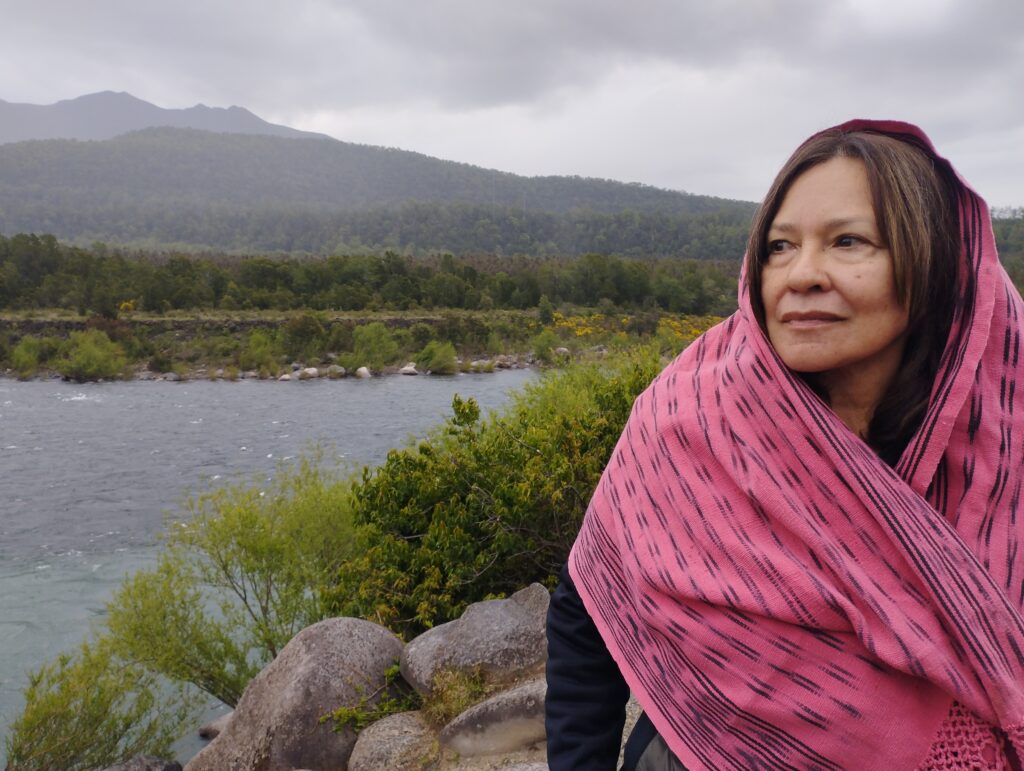
Photo credits: Isadora Soares / International Rivers
The post Recognizing the Rights of the Biobío River: A New Era of Environmental Stewardship appeared first on International Rivers.
]]>